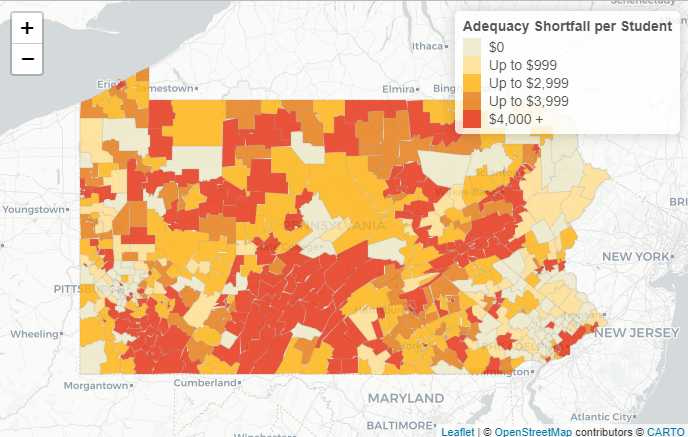
September 12, 2023 – Penn State professor and school funding expert Matthew Kelly has prepared a new analysis of Pennsylvania’s public school funding system for the Basic Education Funding Commission. His study estimates the combined cost of basic and special education for each district to provide an adequately funded education for all students, based on what successful school districts in Pennsylvania are currently spending, relative to their students’ needs.
The study found a total statewide funding shortfall of $6.2 billion, concentrated in deep shortfalls faced by the state’s poorest districts. This is an amount equivalent to 20% of current educational expenditures. 51% of the total shortfall statewide is found in the state’s lowest-wealth districts serving 20% of the state’s students.
Read Dr. Kelly’s full report here. View data on adequacy shortfalls for each Pennsylvania school district here. View an interactive map of every Pennsylvania school district’s adequacy here.
Dr. Kelly presented his analysis at the Commission’s first public hearing on Tuesday, Sept. 12 in Allentown. His analysis was covered in the Philadelphia Inquirer and other media outlets in Pennsylvania.
In its decision finding Pennsylvania’s school funding system unconstitutional, Commonwealth Court wrote: “[A]ny plan devised by Respondents at the Court’s direction will have to provide all students in every district throughout Pennsylvania, not just Petitioners, with an adequately funded education, i.e., a ‘thorough and efficient’ one.” (Opinion, 608). Pennsylvania currently makes no attempt to determine the resources students need.
Dr. Kelly’s study provides an estimate using Pennsylvania data of how much each Pennsylvania school district must spend to be successful – an “adequacy target” – and then calculates if districts are spending less than their target (i.e., if they have a shortfall).
- The study found that Pennsylvania has a total statewide shortfall of $6.2 billion (or $6,258,438,239).
- 157 school districts are deeply underfunded, with a shortfall of $4,000 per student or more. They serve more than 680,000 students, 40% of students in Pennsylvania.
- 286 districts have a per-pupil shortfall greater than $2,000 – well over half of the state’s districts.
- A majority (51%) of the total shortfall statewide is found in the state’s lowest-wealth districts serving 20% of the state’s students.
- In 2022-23, 43% of the state’s Black and Latinx public school students were enrolled in one of the state’s lowest-wealth districts.
- 412 school districts have a shortfall:
-
- These districts educate 83% of Pennsylvania students
- The median per-pupil shortfall of all districts is $2,572
- Districts with shortfalls are located in 64 of 67 counties
Methodology
The study relies on state standards and data. Pennsylvania sets goals for graduation rates and academic assessments, and it recognizes in its funding formulas that some students have greater needs – including students who are learning English and low-income students – and require more support to have the same opportunities.
A previous analysis completed by Dr. Kelly as an expert witness in the school funding lawsuit used a different method, which did not consider special education spending, charter school reimbursement, and other costs—costs that were identified by the Court’s decision as significant factors. That prior analysis was also based on a 2008 formula in state law, not the state’s current formulas, and it did not reflect Pennsylvania’s more rigorous academic standards, which were adopted in 2013.
The new study starts from an analysis of how much is spent per student by districts that are meeting the state’s own standards. Dr. Kelly analyzed spending data from 74 districts that met state graduation rate goals and standardized testing goals. He determined how much they spent per student after factoring in their students’ needs, setting a cost in the district for a student with no identified additional needs (meaning not English learners, students entitled to special education, etc.).
Then, after removing outlier districts spending much more or much less than this group of model districts as a whole, he found the median per student spending relative to need of these remaining model districts and used this figure as a base cost.
Dr. Kelly calculated a target for each district by multiplying the base cost times the district’s number of students as adjusted by the weights in the Basic Education and Special Education Funding formulas. This provides each school district the same level of resources relative to their students’ needs as Pennsylvania school districts meeting state academic goals.
The adequacy target accounts for all public school costs except facilities and pre-K. The costs include special education, charter school reimbursements, pension contributions, transportation, and other costs, in addition to K-12 general education.
The Current System
Dr. Kelly’s testimony also discussed Pennsylvania’s current school funding system. The lowest-wealth districts in Pennsylvania are also the districts with the most students who need more support to reach meaningful opportunities. In the poorest quintile of districts, 65% of students are low-income–more than double the percentage in the wealthiest quintile.
The poorest quintile of districts are paying higher tax rates (21.4 equalized mills) than the wealthiest (18.1), but are able to raise far less funding. The poorest quintile of districts spends $6,230 less per student, relative to their students’ needs, than the wealthiest.
All this has consequences for student achievement. None of the state’s poorest quintile of school districts met the state’s academic benchmarks.
Students who face challenges can succeed with adequate resources. Students from low-income families who attend school in wealthy school districts outperform their peers in low-wealth districts across measures of academic performance. Quoting the Court’s decision: “From these statistics, the Court concludes that money does matter, and economically-disadvantaged students and historically underperforming students can overcome challenges if they have access to the right resources that wealthier districts are financially able to provide.” (Opinion, 717).
